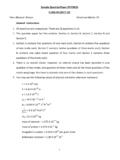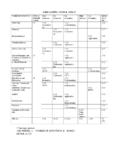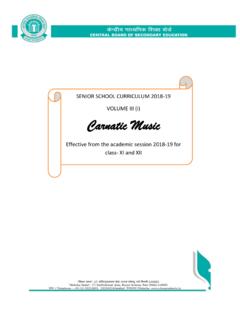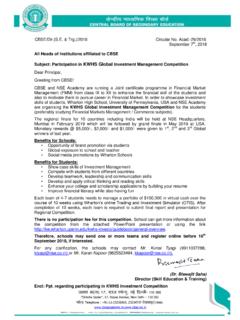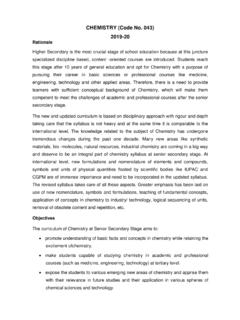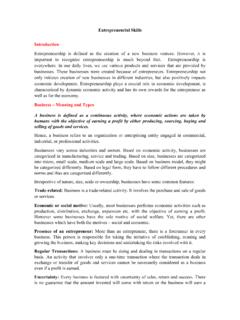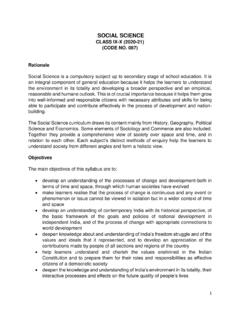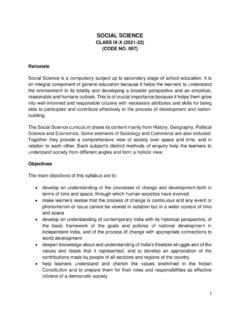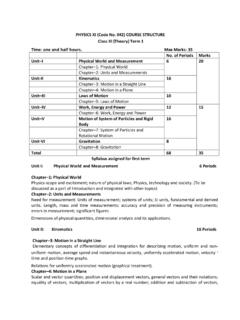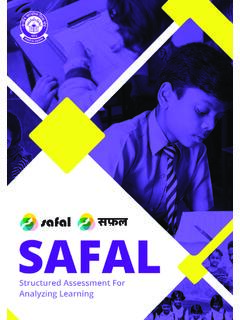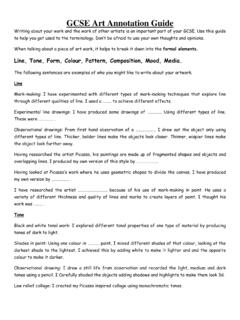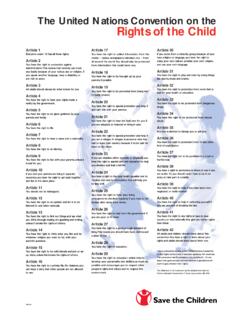Transcription of ART EDUCATION (CODE No. 502) - cbseacademic.nic.in
1 225 ART EDUCATION (CODE No. 502)RationaleArt EDUCATION constitutes an important area of curricular activity for the development of the wholesome personality of the learners. Art is a process of fulfilment running through every aspect of life and it goes on in a creative, productive and joyful manner. Art EDUCATION helps to explore various means of communication (verbal and non-verbal). It encourages to develop creative expression and sharpens senses through keen observation of the environment. It helps to discover preferences through exposition to variety of material and identify the personal form and style of expression. It develops awareness of various art forms in and around the environment and locality and develops skills in the use of various tools, instruments and other art materials in the process of experimentation and exploration. In the process of discovering space, organization, colours, forms, lines, texture, movement, sound, etc.
2 , learners develop a sense of organization and design which inculcates in them a sense of order with regard to their personal appearance, home, school and community. It also develops aesthetic sensibilities and respect for social values and cultural idea of creative art involves all the elements of commonly known art forms visual, performing and language arts, namely music, dance, drama, drawing and painting, modelling and sculpture, or construction work, pottery and ceramic work, poetry and creative writing and other connected craft objectives of art EDUCATION are to : help learners to consolidate past experiences and knowledge; introduce learners to different media and techniques and their use for creative and productive expression for common use; provide opportunities for development of awareness about folk arts, local specific arts and other cultural components leading to an appreciation of national heritage; assist learners to use artistic and aesthetic sensibility in day-to-day life situation.
3 Enable learners to achieve a balanced growth as a social being in tune with our culture through project work. get acquainted with the life and work of the local artists/artistes; use resourcefully locally available material to make different products (objects) with the help of the community; refine the sense of appreciation of the beauty of nature through the basic elements of art to Art ActivitiesAt the secondary stage, art EDUCATION is closer to the local folk art and craft and folk theatre. Art is not only to always blindly copy the old masters or copying the teacher s work in a rigid manner but to help learners express themselves in creative and imaginative ways. Creative arts cannot be a substitute of Work EDUCATION under 226which a few artistic activities may be conducted but the approach and product would be the interest of the learner, as far as possible, all the media of creative arts may be placed before them to facilitate selection of one form or a combination of art forms.
4 These are :Visual Arts1. Two-dimensional or Pictorial - Drawing and Painting - Collage Making - Printing - Photography - Computer graphics2. Three-dimensional - Clay modelling and pottery - Carving and sculpture - ConstructionArt is about creative expression of the learners, uniquely contributed by each one. Studying the works of famous artists of the past or present is undertaken to orient the learners to varied expressions. Replicating or copying either the Master or the teacher s work will check the imagination of the students and therefore must be avoided in all and Language Arts Music (Vocal, Instrumental) Movement and Dance Creative Drama and Puppetry Creative Writing and PoetrySources for Art TeachingThe arts programme in schools must reflect the ethos of the region. Artistic expression in music, poetry, dance theatre and in the creation of forms have been part of human life from the very beginning.
5 It is an integral part of human existence. Exposure to the local environment and arts must be treated as an essential activity of the school art individual expression, the arts provide an opportunity to the learners to study and appreciate the contributions made in the past and present. By learning to appreciate music, painting, dance and theatre, students develop aesthetic sensibility and sensitivity to understand people from other cultures. To build a harmonious society, a productive nation or a world, requires to make learners familiar with the tradition of arts of the local region. The strength and confidence gained from the familiar, will make it possible for her to respect and appreciate the culture and contribution made by creative expression essentially depends on the approach to create opportunities for learners to explore, imagine and communicate the same in an art form they feel confident to use.
6 Availability of material and experts closer to the school or community can be VISUAL ARTSSYLLABUSWhen the school(s) can provide art teachers in different media the following syllabus may be adopted. Activities in terms of Materials/Media and or Pictorial Activities Study of visual resources and means of creative expression. - Study of lines, strokes, colours, shades, tones, textures, etc. while organizing two dimensional space with two dimensional and three dimensional shapes and forms. - Sketching from nature and surrounding. - Creative use of colours to show space, atmosphere, subjective moods. - Creative use of perspective in spatial relationship. - Study of calligraphic strokes of Devnagari and Roman alphabet (Scripts). - Use of contrast as an expressive element of art. - Study and use of various media and techniques to the extent of their availability.
7 - Pencil, charcoal, water colour, crayon, oil colours, poster colour and gouache, acrylic colour and other unconventional sources of colours such as vermillion, yellow and red earth, rice flour, and tools like painting brushes for water colours and oil colours, Painting surfaces such as papers of various kinds and quality, like smooth, rough, thick, thin, etc., canvas, hardboard, simple marking cloth pasted on paper, etc. - Collage and mosaic work with a variety of coloured papers and coloured printed pictures/photographs from magazines and newspapers. - Printing : Mono printing, Printing with wood-cut blocks, lino-cut and metal foil : serigraphy (silk screen), self-made stencil, etc. - Basic knowledge of computer or sculptural activities Study of basic forms in clay - Study of various materials such as clay, plaster of paris, soft-stone, wood (blocks, twigs and branches, roots, etc.)
8 , metal scraps, plastic sheets, wire thread, papers and cardboards, vegetables and other throw-away available materials. - Study of natural and man-made forms, human figures, birds, animals, vegetation and other objects like household items, buildings or as desired by the - Objects of day-to-day use in groups and in different settings and in two and three-dimensional subjective forms and utility and functional art and craft forms in different media and techniques. Painting, murals, graphics, clay modelling, wood-carving, soft-stone, plaster of paris, block of brick constructions, collage mobils, applique, pottery and ceramics, masks, and puppets, textile designing (including tie-dye and batik, and block printing) poster designing, lay-out illustrations and photography, Art Activities with Other School Activities Construction of puppets and their costumes and improvised puppet stage or theatre, correlation with Home Science and Arts (Drama) subjects.
9 Aesthetic organization of the physical environment by enhancing the surrounding area, , landscaping including plantation of trees and other flowering plants and vegetables, etc., correlating with Agriculture, Home Science and Environment Studies activities. Constructing stage setting props such as curtain, backdrops, stage lighting, improvised furniture sets, etc., designing utility (crafts) items; correlating with Work EDUCATION activities. Designing the school magazine and bulletin boards, making posters for school functions, and greeting/invitation cards, stage scenes for music, dance, drama performances, etc., correlating with applied Art activities. Note: These activities and other group activities may emerge in project form at individual levels Activities Organization, display and exhibitions of students periodical and sessional work.
10 Organizing inter school art exhibitions to widen their interaction and horizon. Planning and organizing festivals and celebrations of the community, cultural evenings, musical concerts, film shows and other performances including regional and folk (traditional art forms). Participating in study visits to museums, botanical gardens, zoological garden, art galleries and art institutions, etc., for greater awareness of the environment and cultural Understanding of Art and Culture Short notes on important aspects of Indian art and culture based on Social Science. Such writing may be based on reproduction of art work printed in Textbooks. Contribution made by any one contemporary artist. Knowledge of terms : Contour, texture, graphic, form, volume, space, tone, printmaking, collage, amateur, modelling in relief, mobil construction, applique, calligraphy, layout, poster and Performing ArtsMusic (Vocal) Theory - Knowledge of the terms: Sangeet, Nad, Swar, Shudh, Komal, Teevra, Saptak, Mandra, Madhya Tar, Aroha Avaroha, Raga, Laya, Matra, Tal, Avartan, Sam Tal.
